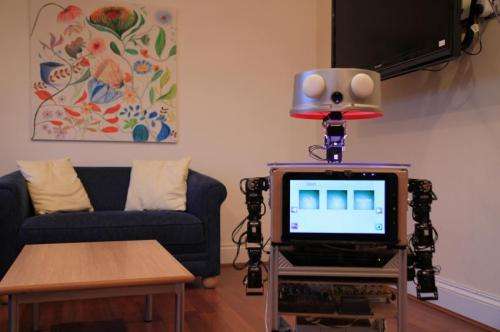Making robots more trustworthy

Researchers from the University of Hertfordshire are part of a new £1.2 million project that aims to ensure that future robotic systems can be trusted by humans.
Robots are increasingly being developed to serve as active "helpers" in situations where humans require assistance to undertake certain tasks – tasks such as being home companions for older people or personal care robots to help patients during their recovery. This means that the humans involved must be fully confident in robot behaviour if human-robot teamwork is to become viable and productive.
"Trustworthy Robotic Assistants" is a three and a half year project funded by the Engineering and Physical Sciences Research Council (EPSRC) that will explore how robots can participate in sophisticated interactions with humans in an increasingly safe and trustworthy manner. It will address issues concerning the barriers between robots and humans that have hampered the development of human-robot interactions, and will look at not only whether the robot makes safe moves but whether it knowingly or deliberately makes unsafe moves.
Professor Kerstin Dautenhahn, from the University of Hertfordshire's Adaptive Systems Research Group, said: "People need to be able to trust robots that they come into contact with. As part of this new project, our research team here in Hertfordshire will focus on safety issues and trustworthy behaviour in the application of robots as home companions. This research will be carried out in our Robot House where we can observe these behaviours in a realistic environment."
The Adaptive Systems Research Team at the University is internationally recognised for their research into adaptive systems, particularly for robots in therapy and education, 'affective' and expressive interfaces between humans and machines, and robotic agents that can learn by imitation.
The Hertfordshire researchers have been involved in several European projects since 2004, investigating how robots can provide socially acceptable and useful assistance as a home companion. This research has been conducted in the University's Robot House, a domestic smart home particularly suitable for human-robot interaction experiments. The research team is currently coordinating the EU project "ACCOMPANY" which is developing a robotic home companion for supporting assistive living of elderly people in their homes.
The Trustworthy Robotic Assistants project involves teams from the University of Hertfordshire's Adaptive Systems Research Group (involving Professor Kerstin Dautenhahn and Dr. Farshid Amirabdollahian), the University of Liverpool's Centre for Autonomous Systems Technology (led by Professor Michael Fisher and Dr. Clare Dixon, and the Bristol Robotics Laboratory, as well as Industrial partners including the British Automation and Robot Association (BARA) and RU Robots Limited.
Professor Michael Fisher, principal investigator at Liverpool and Director of the University's Centre for Autonomous Systems Technology, said: "The assessment of robotic trustworthiness has many facets, from the safety analysis of robot behaviours, through physical reliability of interactions, to human perceptions of such safe operation."
Liverpool's researchers are internationally recognised for their research on logic, formal analysis, and the foundations of autonomy and, both within the multidisciplinary Centre for Autonomous Systems Technology and within the "Trustworthy Robotic Assistants" project, their role is to provide a rigorous formal basis for developing reliable, safe and trustworthy autonomous systems.
Provided by University of Hertfordshire




















